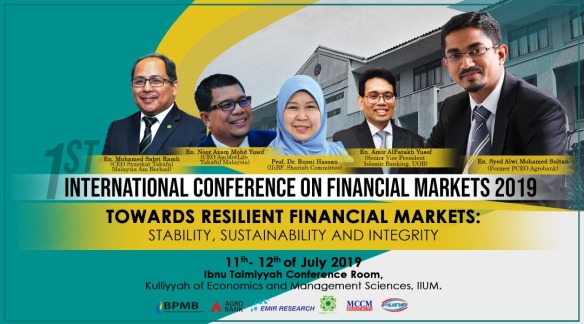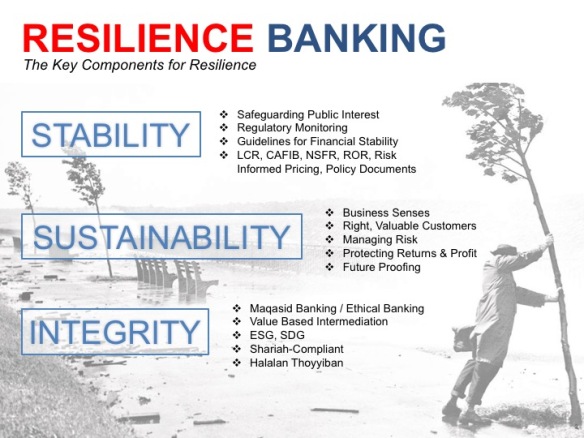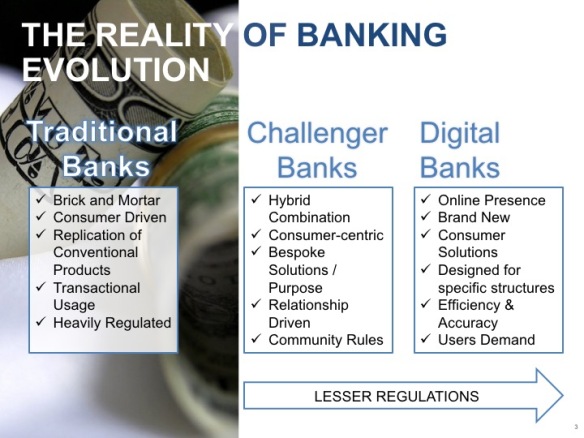Recently, I was invited to be part of a panel to present our views at the International Islamic University of Malaysia (IIUM) on how to make Islamic Financial Markets resilient. With great excitement I prepared my slides (panelists are given 20 minutes to present) and tried to figure out the best approach to present it in such a short time. However, when the session came, due to time overshoots and constraint, me as the last speaker was only left with 10 minutes. I had to make it count, so I talked fast.
Afterwards, however, I do not feel as if it was mission accomplished. Time was too short for me to put my argument properly and I had to drop many points in fear of cramming too much information into that 10 minutes. So I decided to post my slides up, and make a proper short commentary on what I meant to be communicated. Bear with me.
The Financial Industry Must be Resilient
- STABILITY : The public must be confident on the resilience of the financial markets where the public is assured that there is not misconduct of public funds in the day to day operations of the banking industry. BNM has put in great lengths to ensure stability via sufficient capital, liquidity and funding. The operations of the bank must always meet the statutory requirement on financial stability with the introduction of the Liquidity Coverage Ratio (LCR), Net Stable Funding Ratio (NSFR), Rate of Return Framework (ROR), and Risk Informed Pricing.
- SUSTAINABILITY : Any business, must intend to survive in the long run. Selecting your customers are important, and risk mitigation mechanisms must be available to defend the business. But at the same time, re-investment of profits must also be made for future growth, so it is a balance to be maintained.
- INTEGRITY : As Bankers, integrity always plays an important, and fundamental, part. But Islamic Bankers, another layer of integrity is also imposed which is Shariah. Banks are expected to be more and more of a moral champion in support of the various SDGs and ESGs where the idea of being good will eventually lead to better profits and prosperity. BNM’s Value Based Intermediation aims to expand the role of banks to be more than just profit driven, but more inclusive to embrace a wider range of customers and cater for their needs.
The Challenges are manifold.
Being resilient is always a challenge for the Banks, especially with so many moving parts in the financial world. New regulations, new competition, new structures, new products and new models continue to plague the banking industry. To change our mindset to make Banking and Financial Market more better requires a lot of soul searching and will power to make the change. I summarised the challenges into 3 broad categories:
- Consumer Market. Any major change in the banking model is not taken well by the consumer market. Customers come to the Bank mostly for advise on their banking services. The Banks struggle to introduce differentiating products, from the debt structures and into the thought of creating value through investments. I am not sure how successful introducing the VBI into the consumer market, but the has been a lack of awareness programmes to introduce to the public.
- Corporate Market. Corporates are driven by profits and benefits. It is their core function ie to increase shareholder value.
- Financial Markets. We lack sufficient financial instruments in the market. That is why the industry can only grow organically. It needs the strong-will to pump more capital into the market and creation of structures that do not mirror the conventional books.
The Reality is that Traditional Banks need to keep up.
- Traditional Banks. Heavily regulated to ensure financial stability. But the speed of adaptation to new thinking and new technologies are too slow. It is high cost to make the change, but also it is high cost just staying where you are. Ask Nokia. If all Islamic Banks do is replicate, they are in danger of becoming obsolete in the near future.
- Challenger Banks. Provides alternative banking structures or arrangement, with little or no hassle, with or without the use of technology. A lot of customers now by-pass banks to opt for the most convenient and fast banking products. With very minimal regulatory requirements.
- Digital Banks. This new breed of banks are definitely very interesting. There are two differentiators i.e. 1) Banks that only digitalise their processes and paperwork and speed, but the fundamental bricks are the same, and 2) Banks that try to be different and offer a totally new proposition with a new set of bricks. Yet, Islamic Banks are expected to do all and adopt more stringent requirements when entering into the Digital space, while dealing with old issues such as constructive ownership and Aqad. More importantly, these issues can probably be resolved by NON-BANKS, offering the same terms and conditions, sometimes with slightly better proposition such as speed, accuracy and low cost. For example, big data companies such as Facebook and Grab intend to open their own “bank”. Facebook just launched its Libra bank trading in cryptocurrencies. Grab is rumoured to enter as well and these Big Data companies already have their database of ready customers for them to roll out their Digital Banks.
Stop Looking at Your Feet. Stretch out your hand and move to touch new Horizons.
A lot of discussions have been held between the academia and practitioners. It seems we are always looking ways to innovate and integrate into the future, but without any real solutions on how to actually do it. As mentioned, the will-power to affect change remains a huge challenge. Instead of “What Is….” to be turned to “What If…” where solutions are always been discussed and developed for a solution, and “What Next…” clearly implying the shift in banking products from traditional to new developments.
It is no longer sustainable to just replicate. True innovation is on the rise. New solutions are needed to be offered to the customers.
The Next Generation bankers must familiarise themselves with all the blockchain and Internet of Things language and terms currently floating around. More importantly, there should be a look at the whole ecosystem to see where the Shariah elements can be included, and where others must be excluded. Collaborative discussions, between regulators, academicians, practitioners and Shariah scholars must work together for the growth in the industry. It is not just any growth, it involves a total paradigm shift to adopt the new ecosystem.
There is a need to differentiate and upscale the business practices. While we continue to focus on the Traditional Bank in making it more resilient, we might miss this opportunity to join the Industry Revolution 4.0 to revamp Islamic Banking and overlook the threats coming from other financial institutions (NON-BANK). This is the Banking disruption in real life.
















